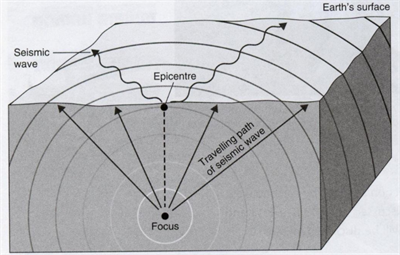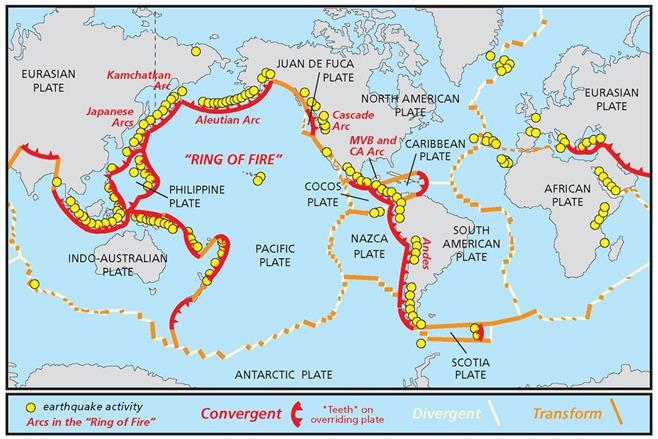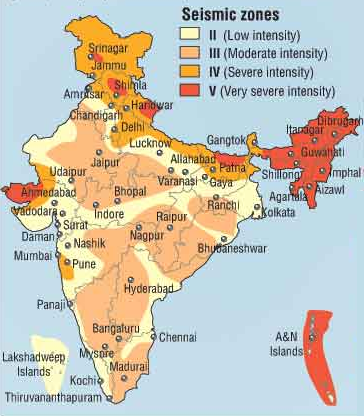
PUMPA - SMART LEARNING
எங்கள் ஆசிரியர்களுடன் 1-ஆன்-1 ஆலோசனை நேரத்தைப் பெறுங்கள். டாப்பர் ஆவதற்கு நாங்கள் பயிற்சி அளிப்போம்
Book Free DemoEarthquake is a shaking of the ground produced by the release of energy. It can occur anywhere (land and ocean), but strong earthquakes are most likely to happen near the plate boundaries.
The sub-surface location (below the surface to a depth of \(700\) \(kilometres\)) where the earthquake originated is called the Earthquake focus. The earthquake epicentre is a point on the earth’s surface that lies directly above the focus (where the shocks felt). The vibrations generated during earthquakes are called seismic waves. It is caused by a sudden collapse or an explosion of rock within the earth (\(Fig. 6\)).
There are three types of seismic waves:
- Primary Waves or P Waves (\(1\) to \(14\) \(kilometres/second\)): These are first waves generated during the earthquake. They are fastest among the other waves to reach the earth's crust. These can pass through solid, liquid and gases.
- Secondary Waves or S Waves (\(1\) to \(8\) \(kilometres/second\)): Waves that travel after the primary waves and can pass only through solid. The particle movement in the S-waves is perpendicular to the wave direction.
- Surface Waves or L Waves (\(2\) to \(6\) \(kilometres/second\)): The Surface waves travel near the ground’s surface at a very slow velocity. These are the most destructive waves.
A seismograph is an instrument used to record the motion of the ground during an earthquake. A seismogram is the recording of the ground shaking at a specific location. The Richter scale is the most common method of measuring earthquakes.

\(Fig. 6\ \)– Earthquake: Focus, Epicentre and Seismic waves
Causes of Earthquakes
Effects of Earthquakes
The effects of earthquakes can be classified as primary effects and secondary effects.
The primary effects are:
- Ground motion - Can damage and sometimes completely destroys buildings, dams, etc.
- Surface rupture - Faults break the ground surface, buildings splits, roads disrupts, etc.
The secondary effects are:
- Fires - Ground movement displaces stoves, breaks gas lines and loosens electrical wires, thereby starting a fire.
- Landslides - Earthquake vibrations may cause soil to slip and cliffs to collapse in the steep slope regions.
- Liquefaction - It is a phenomenon that turns solid ground into a liquid-like state.
- Tsunami - It is a seismic sea wave initiated by sudden movement of the seafloor caused by an earthquake, volcanic eruption, or underwater landslide.
Distribution of Earthquakes
Earth’s major earthquake belts are the margins of tectonic plates.
- The most important earthquake belt is Circum-Pacific Belt. This Belt is associated with volcanic activity and popularly known as the “Pacific Ring of Fire”. It accounts for about \(68\)per cent of all earthquakes.
- The second belt, termed as “Alpine Belt” includes “The Alps” in Europe and the “Great Himalayas” in Asia accounts for \(31\%\).
- Apart from the two belts, it may also occur in some other regions, mostly along the oceanic ridges (ridges of Arctic, Atlantic and western part of Indian Ocean) and the rift valleys of East Africa (\(Fig. 7\)).

\(Fig. 7\) – Earthquake Regions of the World
Earthquake zones in India
The earthquake (seismic) zones of the Indian subcontinent are divided into four zones with respect to its severity (\(Fig. 8\)).

\(Fig. 8\) – Earthquake Regions of India
- Zone V: Andaman & Nicobar Islands, all of North-Eastern India, Parts of North-Western Bihar, Eastern section of Uttaranchal, Himachal Pradesh, the surrounding region of Srinagar in Jammu & Kashmir and the Rann of Kutch in Gujarat.
- Zone-IV: Includes Jammu & Kashmir exclusive of Srinagar region, parts of Himachal Pradesh, Union Territory of Delhi, Sikkim, northern parts of Uttar Pradesh, Bihar and West Bengal, parts of Gujarat and small portions of Maharashtra near the west coast and Rajasthan.
- Zone-III: Consists of Kerala, Goa, Lakshadweep islands, Uttar Pradesh excluding northern part, Gujarat, West Bengal, parts of Punjab, Rajasthan, Madhya Pradesh, Bihar, Jharkhand, Chhattisgarh, Maharashtra, Orissa, Andhra Pradesh, Tamil Nadu and Karnataka.
- Zone-II: Covers other than the above-said parts of India.